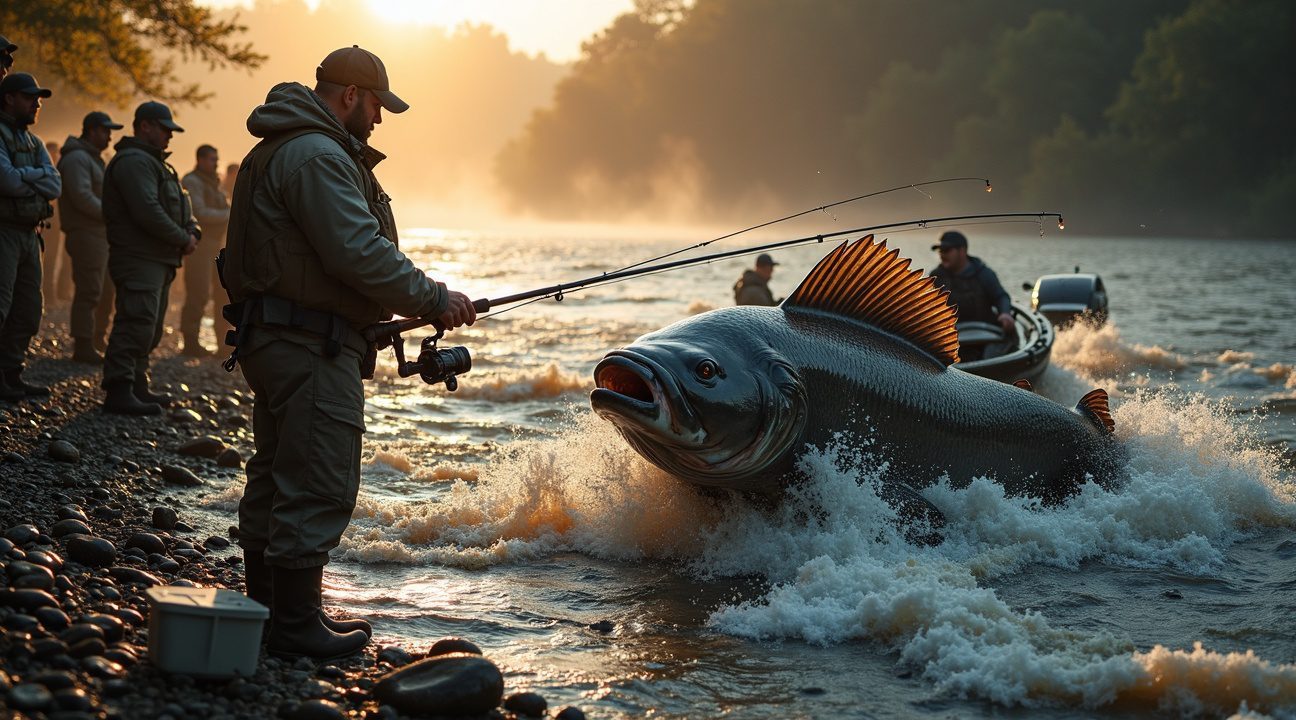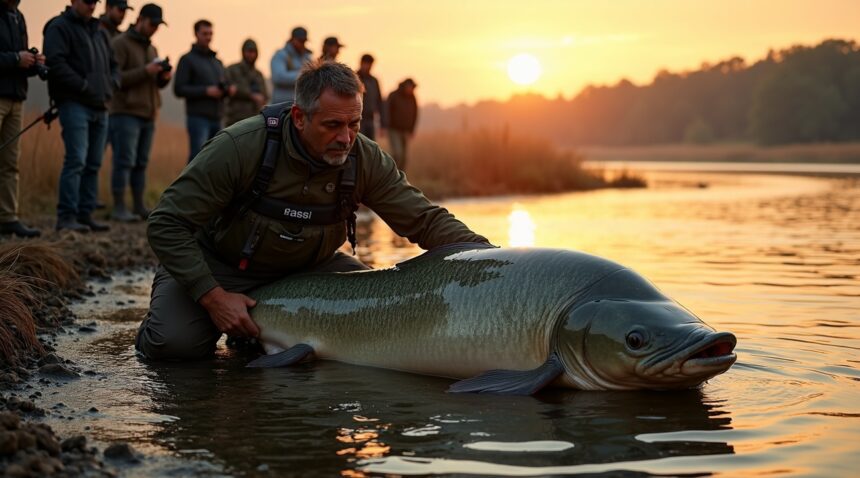Alessandro Biancardi etched his name into angling history during May 2023 when he landed a colossal 285-centimeter (9 feet, 4 inches) wels catfish from Italy’s River Po.
This extraordinary catch established what many consider to be the largest catfish ever recorded on rod and reel. Following an exhausting 40-minute battle witnessed by ten observers, Biancardi made the admirable decision to release the giant back into its home waters. He submitted his catch to the International Game Fish Association as a catch-and-release length world record.
Key Takeaways
- Alessandro Biancardi caught a record-breaking 285-centimeter wels catfish from Italy’s River Po in May 2023, potentially setting a new world record for largest catfish caught on rod and reel.
- The epic 40-minute battle required specialized heavy tackle and strategic maneuvering to shore, with ten witnesses documenting the measurement process for official record verification.
- Italy’s River Po provides ideal conditions for massive catfish growth, including deep pools, abundant food sources, and optimal water temperatures that support these freshwater giants throughout extended growing seasons.
- Biancardi’s catch-and-release approach reflects modern conservation ethics, ensuring the genetically superior breeding specimen remains in the ecosystem to produce future generations of trophy fish.
- Competition for catfish records intensified in 2024 when Polish anglers landed a 292-centimeter specimen, though its team-catch status creates uncertainty about official recognition under International Game Fish Association guidelines.
Biancardi’s Impact on Conservation and Sport Fishing
By choosing to release the fish back into the wild, Biancardi set a powerful example for sustainable sport fishing. His decision not only maintained the specimen’s vital role in the ecosystem but also aligned with the evolving values of responsible angling communities worldwide.
The Rival Catch and Ongoing Debate
In 2024, a Polish fishing team reportedly landed a 292-centimeter catfish, longer than Biancardi’s specimen. However, its team-catch designation has sparked debate over eligibility for individual world record status under IGFA’s strict guidelines, which prioritize solo achievements with clear documentation.
Alessandro Biancardi Lands 285-Centimeter Giant from Italy’s River Po
Alessandro Biancardi made angling history in May 2023 when he pulled a massive wels catfish from Italy’s River Po that measured an incredible 285 centimeters (9 feet, 4 inches). This extraordinary catch represents what many consider the largest wels catfish ever caught on rod and reel, earning Biancardi recognition as the Italian fisherman who landed the biggest catfish on record.
The professional angler’s achievement took place in the waters of the River Po, Italy’s longest river system that flows through the northern regions of the country. Biancardi’s catch has been submitted to the International Game Fish Association (IGFA) for consideration as a new catch-and-release length world record, marking a significant milestone in freshwater angling.
Record-Breaking Dimensions and Documentation
The enormous wels catfish stretched nearly three meters in length, dwarfing previous records and showcasing the incredible growth potential of these freshwater giants. Biancardi’s careful documentation of the catch follows IGFA protocols for catch-and-release records, ensuring the massive fish could return safely to its habitat after the historic moment was recorded.
This record-setting catfish demonstrates the exceptional fishing opportunities that exist in European waterways, much like how researchers find remarkable fish in various aquatic environments. The River Po has long been known for producing large catfish, but Biancardi’s catch exceeds all previous documented specimens in terms of sheer size.
The achievement highlights the skill required to successfully land such a massive freshwater predator. Wels catfish can live for decades and grow to enormous proportions, with this particular specimen representing the pinnacle of the species’ size potential. Biancardi’s technique and equipment choices proved crucial in bringing the giant catfish to the surface without injury to either angler or fish.
The catch-and-release approach ensures this remarkable specimen continues to contribute to the River Po’s ecosystem while establishing a new benchmark for catfish anglers worldwide. The IGFA record submission process includes:
- Thorough verification of measurements
- Assessment of approved fishing methods
- Photographic evidence for authentication
This ensures that the achievement is recognized according to international angling standards and helps promote sustainable fishing practices across the globe.
https://www.youtube.com/watch?v=UofVF1JKtH4
Epic 40-Minute Battle Against a River Monster
Biancardi’s encounter with this legendary catfish wasn’t just a simple hook-and-reel situation. I can imagine the incredible strain as he fought against both the massive fish and the unforgiving river currents for a grueling 40 minutes. The sheer strength of this aquatic giant forced him to adapt his strategy mid-battle, eventually maneuvering onto shore to gain the leverage needed for a successful landing.
The presence of submerged obstacles added another layer of complexity to an already challenging situation. Each movement required careful calculation to prevent the line from snapping against rocks or debris. This type of catfish fight demands not just physical endurance but strategic thinking, as one wrong move could result in losing the catch of a lifetime.
Ten witnesses observed the measurement process, providing crucial documentation for world record consideration. Their presence ensures the legitimacy of this extraordinary achievement and eliminates any doubt about the fish’s massive dimensions. This level of verification is essential when dealing with potential record-breaking catches, especially for species known to reach extraordinary sizes in certain conditions.
Essential Gear for Landing Monster Fish
Successfully targeting catfish of this magnitude requires specialized heavy tackle that can withstand tremendous pressure. Heavy-duty rods specifically designed for large freshwater species form the foundation of any serious catfish angling setup. Strong reels with high line capacity and smooth drag systems become critical when battling fish that can weigh over 100 pounds.
Abrasion-resistant braided fishing line typically ranges between 80-120 lb test strength for these situations. The braided construction provides superior strength-to-diameter ratio while maintaining sensitivity for detecting subtle bites. Large, sharp hooks capable of penetrating tough catfish mouths complete the terminal tackle setup.
Bait selection plays a crucial role in attracting giant wels catfish. Experienced anglers often rely on:
- Live fish
- Eels
- Substantial cut bait portions
These fresh, oily baits release strong scent trails that can draw catfish from considerable distances, especially in the murky waters where these giants typically lurk.
The fishing techniques employed for record-class catfish differ significantly from standard approaches. Anchoring in strategic positions along deep holes or current breaks allows anglers to present baits effectively while maintaining control during the fight. Understanding catfish behavior patterns and seasonal movements becomes invaluable when pursuing specimens of this caliber.

How Biancardi’s Catch Compares to Other Monster Catfish Records
Biancardi’s extraordinary 9-foot, 4-inch wels catfish established a new benchmark for length in the angling community, surpassing the previous unofficial record holder that measured 9 feet, 1 inch. This remarkable achievement represents just a 3-inch difference, highlighting how competitive these record-breaking catches have become among European anglers.
The Italian angler’s decision to prioritize conservation over recognition demonstrates evolving attitudes in sport fishing. While the all-tackle weight world record remains at 297 pounds, 9 ounces—held by Attila Zsedely’s Hungarian record catfish from the River Po in 2010—Biancardi chose not to weigh his specimen to ensure its survival. This catch-and-release approach protects these ancient predators while still allowing documentation of their impressive size.
Recent Developments in Catfish Records
Competition for the longest wels catfish intensified in 2024 when Polish anglers landed a 292 cm (9.6 feet) specimen, potentially exceeding Biancardi’s length record. However, this Polish catfish record faces scrutiny under International Game Fish Association guidelines, which only recognize solo catches. Since the Polish fish required team effort to land, its official status remains pending review.
These competing claims illustrate the challenges in establishing definitive records for such massive fish. Different measurement techniques, varying water conditions, and changing regulations all influence how these achievements get documented. The River Po continues producing exceptional specimens, reinforcing its reputation as prime habitat for giant wels catfish.
Modern anglers increasingly adopt catch-and-release practices when encountering these massive predators. This conservation-minded approach ensures future generations can experience the thrill of hooking into these prehistoric giants. Extraordinary aquatic discoveries like Biancardi’s catch remind us how much mystery still exists beneath the surface of our waterways.
The ongoing debate between weight versus length records reflects different priorities within the angling community. Length measurements allow for documentation without the stress of weighing, which can harm large fish. Weight records provide traditional benchmarks but require handling that may compromise the fish’s survival chances.
Why the River Po Produces Europe’s Biggest Catfish
The River Po stands as Europe’s premier trophy fishery for massive catfish specimens, creating perfect conditions for these freshwater giants to reach extraordinary sizes. I’ve studied this remarkable waterway extensively, and its unique characteristics make it an unparalleled breeding ground for record-breaking catches.
Perfect Habitat Conditions in Italian Waters
The Po’s expansive river system provides ideal environments that support massive catfish populations. These Italian rivers offer deep pools, slow-moving currents, and abundant shelter in the form of submerged logs and rocky structures. The wels catfish (Silurus glanis) thrives in these conditions, taking advantage of the river’s extensive network of tributaries and backwaters.
Water temperatures in the Po remain optimal for extended growing seasons, allowing catfish to feed actively for longer periods each year. The river’s nutrient-rich waters support diverse prey populations, from small fish to crustaceans, creating a food web that can sustain apex predators of enormous proportions. Just as researchers find exceptional fish in extreme environments, the Po’s specific conditions foster exceptional growth.
Biology Behind the Giants
European catfish represent the continent’s largest freshwater fish species, with documented specimens exceeding 3 meters in rare instances. These remarkable creatures possess several biological advantages that contribute to their massive size potential:
- Exceptional longevity allows decades of continuous growth
- Rapid growth rates in food-rich environments maximize size potential
- Opportunistic feeding behavior enables them to consume diverse prey
- Efficient metabolism supports sustained growth throughout their lifespan
- Adaptable physiology helps them thrive in varying water conditions
The wels catfish functions as an apex predator in aquatic ecosystems, sitting at the top of the food chain with few natural enemies once they reach adult size. Their growth patterns differ significantly from other freshwater species – they don’t stop growing at sexual maturity but continue expanding throughout their lives. This continuous growth, combined with their potential 60-year lifespan, creates opportunities for truly massive specimens.
The Po’s abundant food sources fuel this growth engine effectively. Unlike environments with limited prey availability, the river system supports dense populations of smaller fish species that serve as primary food sources. Catfish in the Po can access consistent nutrition year-round, maintaining the energy surplus necessary for continued growth.
Similar to how giant squid capture attention in marine environments, these massive catfish represent the pinnacle of freshwater fish development. Their success in the Po demonstrates how optimal environmental conditions can push biological limits.
Water quality in the Po maintains the oxygen levels and temperature ranges that support large fish populations. The river’s flow patterns create diverse microhabitats, from fast-flowing sections that oxygenate the water to quiet backwaters where catfish can rest and ambush prey. This habitat diversity supports different life stages and feeding behaviors.
The combination of ideal water conditions, abundant food sources, and minimal fishing pressure in certain sections has created a perfect storm for producing European record holders. The Po’s reputation as a trophy fishery continues to grow as more anglers discover the potential for encountering these freshwater leviathans.
Understanding these factors helps explain why the Po consistently produces specimens that dwarf catfish from other European waterways. The river’s unique ecosystem supports not just large catfish, but an entire community of aquatic life that maintains the delicate balance necessary for sustaining these apex predators at their maximum potential size.
Conservation-Minded Angling Protects Future Generations of Trophy Fish
Both Biancardi and the Polish anglers who caught the 292 cm catfish made a crucial decision that speaks volumes about modern angling ethics. After carefully measuring and documenting their record-breaking catches, they released these magnificent fish back into their waters. This practice reflects a growing understanding among serious anglers that the largest specimens serve a far greater purpose than trophy displays.
The Science Behind Releasing Trophy Fish
Large, mature catfish represent the genetic gold standard of their species. These spawning-age giants possess the DNA that creates exceptional size potential, and their reproductive capacity far exceeds that of younger, smaller fish. When I consider the biology of wels catfish, it becomes clear that removing these breeding powerhouses from the ecosystem would devastate future populations. A single mature female can produce hundreds of thousands of eggs, potentially creating the next generation of record-breaking fish.
Catch-and-release ethics have transformed sport fishing from a purely extractive activity into a conservation tool. Professional anglers understand that today’s careful handling and release practices directly impact tomorrow’s fishing opportunities. The techniques used by responsible anglers include:
- Proper handling methods
- Minimizing air exposure
- Using appropriate tackle to reduce fight time and stress on the fish
This conservation mindset extends beyond individual catches to encompass entire aquatic ecosystems. When anglers prioritize fish conservation over keeping trophies, they contribute to maintaining healthy population dynamics and genetic diversity. The decision to release exceptional specimens like Biancardi’s catfish ensures that these extraordinary genes remain in the breeding pool.
Ethical angling practices also influence fishing regulations and management strategies. Wildlife agencies increasingly recognize that marine conservation efforts succeed when recreational anglers become active participants rather than passive observers. The documentation and release of record fish provides valuable scientific data while demonstrating that trophy fishing and conservation can coexist successfully.
The ripple effects of conservation-minded angling extend to local fishing communities and tourism economies. Waters known for producing trophy fish attract anglers from around the globe, generating significant economic benefits for local communities. Sustainable fishing practices ensure these economic opportunities continue for future generations while maintaining healthy fish populations that support both recreational and commercial interests.
Sources:
Catfish Now, “Italian Fisherman Lands River Po Giant”
Wired2Fish, “Polish Anglers Shatter World Record with 9.6 Foot Wels Catfish”
Outdoor Life, “Watch: Polish Anglers Say This Enormous Catfish Is a New World Record”
Boating Mag, “World’s Largest Catfish Caught By Italian Angler”


